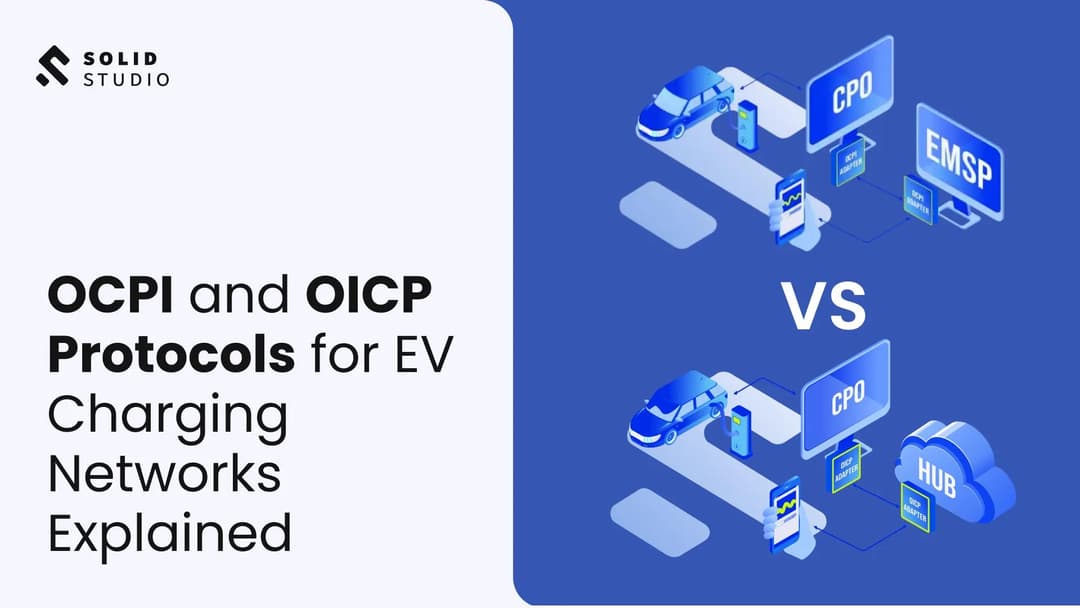Every new EV charging network begins with the same question. How do we make our stations visible, usable, and trusted across multiple EV charging systems without drowning in custom integrations? The answer sits in the EV charging protocols behind the scenes.
OCPI and OICP run the data exchange that keeps charging locations discoverable, sessions authorized, tariffs clear, and roaming partners synced. They help CPOs, eMobility Service Providers, and enterprise teams launch scalable charging services without rebuilding the wheel for every partner.
The next sections break down how OCPI and OICP work and why they matter for the future of efficient charging networks.
Why open standards matter for EV charging networks
EV charging businesses grow through partnerships. You run charge points, connect with eMSPs, exchange data with roaming platforms, and support EV drivers who expect accurate information at all times. Every partner depends on clean data and fast synchronization. When each system uses its own logic, integrations slow down and operations get messy.
Open standards fix this. OCPI and OICP give the market a shared way to exchange charging point locations, tariff information, session data, authorization, and smart charging commands. They help CPOs and eMSPs expand coverage, cut down onboarding time, and keep billing consistent across different EV charging networks. For electric vehicle owners, this means predictable access to charging stations with a single account and a unified experience across multiple networks.
Open communication protocols keep EV roaming stable, operations efficient, and allow any charging management system to scale without building one-off workarounds for every partner.
What OCPI is and how it works
Open Charge Point Interface (OCPI) is a structured protocol designed to let EV charging systems exchange data precisely and reliably. It defines how CPOs, eMSPs, and roaming partners share information on charging stations, live status, connector types, pricing, tokens, and session progress. Instead of building custom logic for each partner, companies follow one standard that keeps data aligned across different EV charging networks.
The strength of OCPI comes from its clarity. It defines how platforms connect, how they sync real-time updates, and how they handle the charging process from discovery to billing. This removes a large amount of technical overhead and cuts integration time for any operator entering new markets.
OCPI runs in real time and is known for transparent data exchange, which helps service providers deliver accurate information to EV drivers. It also has global recognition and is actively maintained by the EVRoaming Foundation, which ensures the protocol remains open, neutral, and aligned with industry needs. As the foundation states, “OCPI facilitates roaming by enabling seamless data exchange between market players,” a rule that keeps modern charging infrastructure scalable and predictable.
Learn more about OCPI versions (OCPI 2.1., OCPI 2.2, OCPI 3.0) in our OCPI Protocol Guide.
How do OCPI modules work?
OCPI works through a set of modules that cover the full charging journey. Each module solves a specific part of roaming, authorization, smart charging, or billing. Together, they give CPOs, eMSPs, and roaming partners a reliable way to exchange data across different EV charging networks.
- Credentials: This module sets up trust between partners. It handles the tokens that allow two platforms to open a secure connection.
- Versions: Both sides confirm which OCPI version they support and which modules are available. It keeps the integration clean from day one.
- Locations: This module shares static charge point information and real-time details about availability, connector types, power levels, and opening hours. Drivers depend on this data to find the right charging point.
- Sessions: It tracks the entire charging process. You get time stamps, energy usage, charging status, and session progression. This data powers smart charging decisions and session monitoring.
- Commands: The module allows operators or eMSPs to send actions like remote start or stop. It supports smart charging commands that keep the process smooth for drivers and reliable for network operators.
- Tokens: This module manages authorization. It verifies RFID cards, app users, Autocharge IDs, or any identifier needed to start a charging session.
- Tariffs: Tariff information helps eMSPs and CPOs keep pricing clear. It defines energy rates, time-based fees, parking time, and flat components that shape the final charging cost.
- CDRs: Charge detail records represent the financial truth of a charging session. They include signed meter data, tariff details, timestamps, and energy consumption.
With these modules, OCPI supports peer-to-peer connections, direct bilateral connections, and EV roaming through platforms that rely on the protocol. It keeps data consistent across charging stations, service providers, and charging management systems.
How to implement OCPI
Implementation starts with exchanging initial tokens and confirming the OCPI version through the Credentials and Versions modules. After that, both sides map their internal data to OCPI models and expose the required endpoints.
Once the handshake is active, partners test key flows such as location updates, session authorization, smart charging commands, and CDR delivery. When tests pass, the connection moves to production, and the roaming data sync begins.
What OICP is and how it works
Open Intercharge Protocol (OICP) Hubject’s protocol for roaming between many EV charging networks through a single connection. It sits in the backend layer of the EV charging ecosystem. This means it does not operate at the moment when the car 'talks' to the charging station. That handshake is handled by OCPP and the charger’s hardware. OICP steps in after that point, when platforms exchange data about charging locations, availability, tariffs, session authorization, and CDRs across different networks.
In practice, a car connects to an EV charger, the charger connects to the CPO backend, and the CPO backend uses OICP to communicate with Hubject. The hub routes roaming requests to the correct eMSP or partner network. This setup removes the need for direct connections between each pair of operators.
OICP covers the core roaming use cases: discovering charging stations, authorizing sessions, passing smart charging commands, and delivering CDRs. Companies that join Hubject gain access to many networks with one integration, which speeds up market expansion and simplifies operations. It is a strong fit for businesses that value reach and fast scaling across multiple countries.
OCPI vs. OICP within the EV charging industry
OCPI and OICP solve the same problem, but they take different routes.
OCPI uses a peer-to-peer model. Each CPO or eMSP connects directly to another partner. This gives you strong control over data exchange and flexibility in how you shape business models. It works well for organizations that want tight integrations, custom agreements, or clear ownership of every roaming link.
OICP leans on the power of the hub. You integrate with Hubject once and gain access to a wide network of charging partners. This cuts technical effort and speeds up expansion. It fits companies that focus on reach and simplicity rather than managing every connection themselves.
OCPI brings granular control. OICP brings scale through a central hub. Many operators use both to cover different charging networks and meet market demands. The choice depends on your roadmap, partner strategy, and the level of control you expect over roaming flows.
How CPOs and eMSPs implement these protocols
CPOs and eMSPs use OCPI and OICP to sync their EV charging infrastructure with roaming partners and keep charging sessions flowing without friction. The process starts by exposing the correct endpoints and aligning internal data with protocol models. Charging locations, connector details, tariffs, tokens, and session data must match the structure expected by the partner or roaming hub.
Once the handshake is active, the platform begins to exchange key data in real-time. Charging stations share status updates, smart charging commands flow between systems, and session authorization happens through tokens or app-based IDs. After a session ends, CDRs with signed meter data, timestamps, and costs move between systems to support billing and reporting.
CPO platforms use these protocols to publish charging station data and accept authorizations from roaming EV drivers. eMSP platforms use them to display accurate charging locations, manage payments, and start or stop sessions on external networks. Together, these standards help companies expand their footprint and operate across many charging networks with predictable data and clear financial flows.
What this means for your charging business
OCPI and OICP give you a practical way to grow your charging network without juggling endless custom integrations. These standards help your platform stay compatible with roaming partners, keep tariffs clean, and maintain the real-time data flow your operations depend on. They support clear pricing, accurate CDRs, authorization, and the smart charging features EV drivers expect from a modern network.
If you run a CPO business, these protocols make your stations visible, accessible, and ready for roaming. If you run an eMSP platform, they help you present reliable charging locations, manage payments, and start sessions on external networks without friction. Teams that adopt OCPI or OICP early onboard partners faster, scale across multiple networks, and keep operations predictable.
Solidstudio builds EV charging software systems that match this reality. Our CPO Platform and eMSP Platform support OCPI, OICP, and major roaming partners out of the box. You get a production-ready system with charging station management, roaming configuration, tariff handling, payments, smart charging features, and the admin tools your team needs to run a growing EV charging business.
If you want to build or scale your EV charging offer with infrastructure that’s already aligned with industry standards, explore Solidstudio’s products and see how they fit your roadmap.

